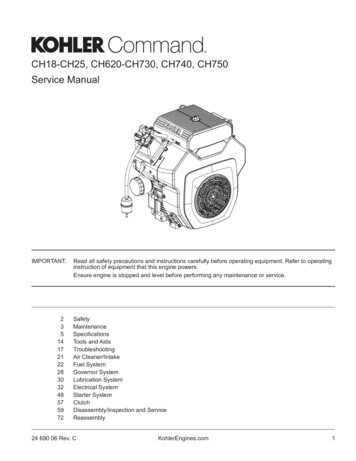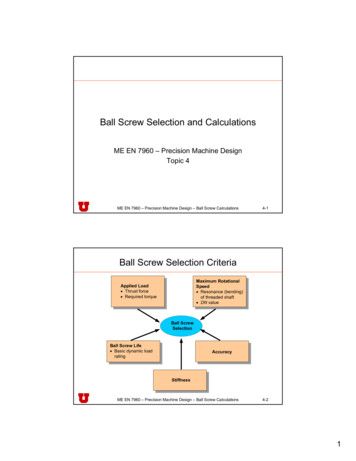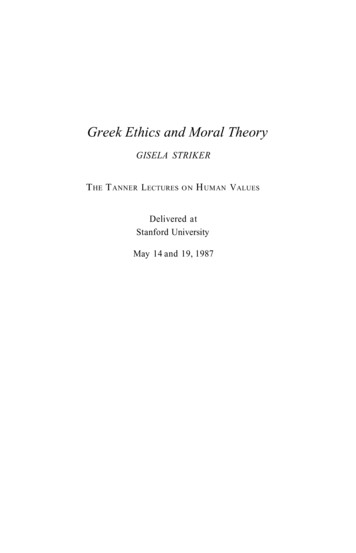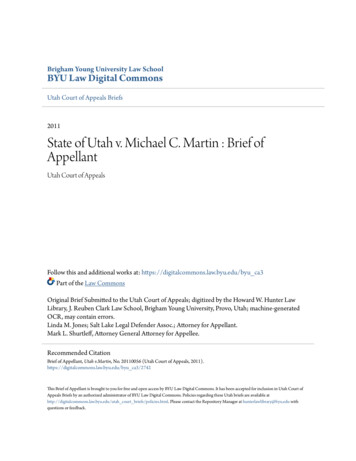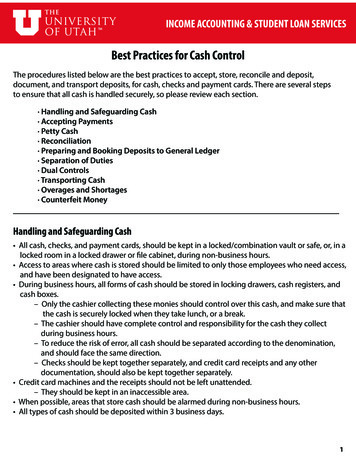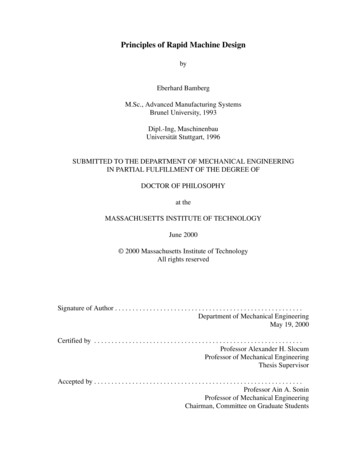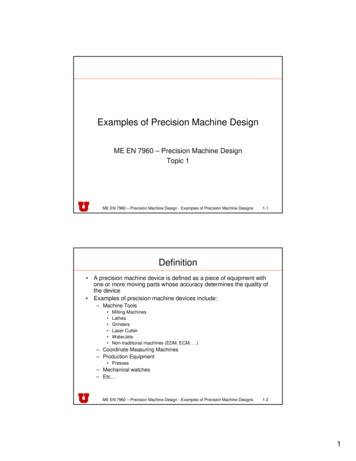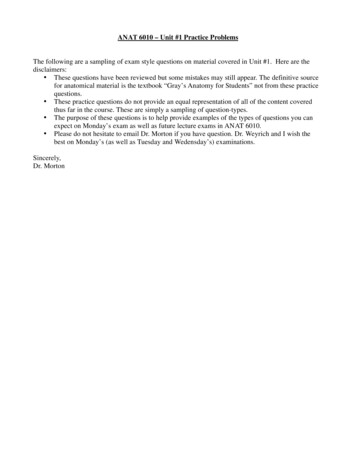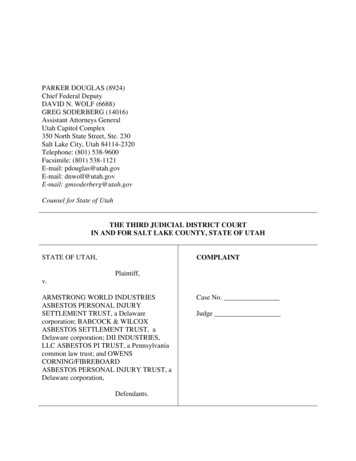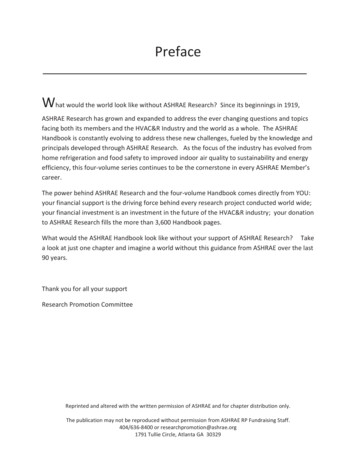
Transcription
PrefaceWhat would the world look like without ASHRAE Research? Since its beginnings in 1919,ASHRAE Research has grown and expanded to address the ever changing questions and topicsfacing both its members and the HVAC&R Industry and the world as a whole. The ASHRAEHandbook is constantly evolving to address these new challenges, fueled by the knowledge andprincipals developed through ASHRAE Research. As the focus of the industry has evolved fromhome refrigeration and food safety to improved indoor air quality to sustainability and energyefficiency, this four-volume series continues to be the cornerstone in every ASHRAE Member’scareer.The power behind ASHRAE Research and the four-volume Handbook comes directly from YOU:your financial support is the driving force behind every research project conducted world wide;your financial investment is an investment in the future of the HVAC&R industry; your donationto ASHRAE Research fills the more than 3,600 Handbook pages.What would the ASHRAE Handbook look like without your support of ASHRAE Research? Takea look at just one chapter and imagine a world without this guidance from ASHRAE over the last90 years.Thank you for all your supportResearch Promotion CommitteeReprinted and altered with the written permission of ASHRAE and for chapter distribution only.The publication may not be reproduced without permission from ASHRAE RP Fundraising Staff.404/636-8400 or researchpromotion@ashrae.org1791 Tullie Circle, Atlanta GA 30329
CHAPTER 18NONRESIDENTIAL COOLING AND HEATINGLOAD CALCULATIONSCooling Load Calculation Principles . 18.1Internal Heat Gains . 18.3Infiltration and Moisture MigrationHeat Gains . 18.12Fenestration Heat Gain. 18.14Heat Balance Method . 18.14Radiant Time Series (RTS) Method .Heating Load Calculations .System Heating and Cooling Load Effects.Example Cooling and Heating Load Calculations .Previous Cooling Load Calculation Methods .Building Example Drawings .HMany cooling load components vary widely in magnitude, and possibly direction, during a 24 h period. Because these cyclic changes inload components often are not in phase with each other, each component must be analyzed to establish the maximum cooling load for abuilding or zone. A zoned system (i.e., one serving several independent areas, each with its own temperature control) needs too provide nogreater total cooling load capacity than the largest hourly sum ofsimultaneous zone loads throughout a design day; however, it musthandle the peak cooling load for each zone at its individual peak hour.At some times off day during heating or intermediate seasons, somezones may require heating while others require cooling. The zones’ventilation, humidification, or dehumidification needs must also beconsidered.EATING and cooling load calculations are the primary designbasis for most heating and air-conditioning systems and components. These calculations affect the size of piping, ductwork, diffusers, air handlers, boilers, chillers, coils, compressors, fans, andevery other component of systems that condition indoor environments. Cooling and heating load calculations cann significantly affectfirst cost of building construction, comfort and productivity of occupants, and operating costt and energy consumption.Simply put, heating and cooling loads are the rates of energyinput (heating) or removal (cooling) required to maintain an indoorenvironment at a desired temperature and humidity condition. Heating and air conditioning systems are designed, sized, and controlledto accomplish that energy transfer. The amount of heating or coolingrequired at any particular time varies widely, depending on external(e.g., outdoor temperature) and internal (e.g., number of peopleoccupying a space) factors.Peak design heating and cooling load calculations, which are thischapter’s focus, seek to determine the maximum rate of heating andcooling energy transfer needed at any point in time. Similar principles, but with different assumptions, data, and application, can beused to estimate building energy consumption, asa described in Chapter 19.This chapter discusses common elements of cooling load calculation (e.g., internal heat gain, ventilation and infiltration, moisturemigration, fenestration heat gain) and two methods off heating andcooling load estimation: heat balance (HB) and radiant time series(RTS).COOLING LOAD CALCULATIONPRINCIPLESCooling loads result from manyy conduction, convection, and radiation heat transfer processes through the building envelope and frominternal sources and system components. Building components orcontents thatt may affect cooling loads include the following: External: Walls, roofs, windows, skylights, doors, partitions, ceilings, and floors Internal: Lights, people, appliances, and equipment Infiltration: Air leakage and moisture migration System: Outdoor air, duct leakage and heat gain, reheat, fan andpump energy, and energy recoveryTERMINOLOGYThe variables affecting cooling load calculations are numerous,oftenn difficult to define precisely, andd always intricately interrelated.The preparation of this chapter is assigned to TC 4.1, Load Calculation Dataand Procedures.18.118.2018.2818.3218.3518.4918.52Heat Flow RatesIn air-conditioning design, the following four related heat flowrates, each of which varies with time, must be differentiated.Space Heat Gain. This instantaneous rate of heat gain is the rateat which heat enters into and/or is generated within a space. Heat gainis classified by its mode of entry into the space and whether it is sensible or latent. Entrymodes include (1)) solar radiation through transEparent surfaces; ((2)) heat conduction through exterior walls and roofs;(3) heat conduction through ceilings, floors, and interior partitions;(4) heat generated in the space by occupants, lights, and appliances;(5) energy transfer through direct-with-space ventilation and infiltrationn oof outdoor air; aand (6)) miscellaneous heat gains. Sensible heat isadded directly to the conditioned space by conduction, convection,and/or radiation. Latent heat gain occurs when moisture is added tothe space (e.g., from vapor emitted by occupants and equipment). Tomaintain a constant humidity ratio, water vapor must condense on thecooling apparatus and be removed at the same rate it is added to thespace. The amount of energy required to offset latent heat gain essentially equals the product of the condensation rate and latent heat ofcondensation. In selecting cooling equipment, distinguish betweensensible and latent heat gain: every cooling apparatus has differentmaximum removal capacities for sensible versus latent heat for particular operating conditions. In extremely dry climates, humidification may be required, rather than dehumidification, to maintainthermal comfort.Radiant Heat Gain. Radiant energy must first be absorbed by surfaces that enclose the space (walls, floor, and ceiling) and objects inthe space (furniture, etc.). When these surfaces and objects becomewarmer than the surrounding air, some of their heat transfers to the airby convection. The composite heat storage capacity of these surfacesand objects determines the rate at which their respective surfacetemperatures increase for a given radiant input, and thus governs therelationship between the radiant portionof heat gain and its corrersponding part of the space cooling load (Figure 1). The thermal storage effect is critical in differentiating between instantaneous heatgain for a given space and its cooling load at that moment. PPredicting
18.22013 ASHRAE Handbook—FundamentalsFig. 1 Origin of Difference Between Magnitude ofInstantaneous Heat Gain and Instantaneous Cooling Loadthe nature and magnitude of this phenomenon to estimate a realisticcooling load for a particular set of circumstances has long been ofinterest to design engineers; the Bibliography lists some early workon the subject.Space Cooling Load. This is the rate at whichh sensible and latentheat must be removed from the space to maintain a constant spaceair temperature and humidity. The sum of all space instantaneousheat gains at any given time does not necessarily (or even frequently) equal the cooling load for the space at that same time.Space Heat Extraction Rate. The rates at which sensible andlatent heat are removed from the conditioned space equal the spacecooling load only if the room air temperature and humidity are constant. Along with the intermittent operation of cooling equipment,control systems usually allow a minor cyclic variation or swing inroom temperature; humidity is often allowed to float, but it can becontrolled. Therefore,proper simulation of the control system givesTa more realistic value of energy removal over a fixed period thanusing values of the space cooling load. However, this is primarilyimportant for estimating energy use over time; it is not needed tocalculate design peakk cooling load for equipment selection.Cooling Coil Load. The rate at which energy is removed at acooling coil serving one or more conditioned spaces equals the sumof instantaneous space cooling loads (or space heat extraction rate,if it is assumed that space temperature and humidity vary) for allspaces served by the coil, plus any system loads. System loadsincludee fan heat gain, duct heat gain, and outdoor air heat and moisture brought into the cooling equipment to satisfy the ventilation airrequirement.Time Delay EffectEnergy absorbed by walls, floor, furniture, etc., contributes tod only after a time lag. Some of this energy is stillspace cooling loadpresent and reradiating even afterfthe heat sources have beenswitched off or removed, as shown in Figure 2.There is always significant delay between the time a heat sourceis activated, and the point when reradiated energy equals that beinginstantaneously stored. This time lag must be considered when calculating cooling load, because the load required for the space can bemuch lower than the instantaneous heat gain being generated, andthe space’s peak load may be significantly affected.Accounting for the time delay effect is the major challenge incooling load calculations. Several methods, including the two presented in this chapter, have been developed to take the time delayeffect into consideration.COOLING LOAD CALCULATION METHODSThis chapter presents two load calculation methods that varysignificantly from previous methods. The technology involved,however (the principle of calculating a heat balance for a givenspace) is not new. The first of the two methods is the heat balance(HB) method; the second is radiant time series (RTS), which isFig. 2 Thermal Storage Effect in Cooling Load from Lightsa simplification of the HB procedure. Both methods are explainedin their respective sections.Cooling load calculation of an actual, multiple-room buildingrequires a complex computer program implementing the principlesof either method.Cooling Load Calculations in PracticeLoad calculations should accurately describe the building. Allload calculation inputs should be as accurate as reasonable, withoutusing safety factors. Introducing compounding safety factors atmultiple levels in the load calculation results in an unrealistic andoversized load.Variation in heat transmission coefficients of typical buildingmaterials and composite assemblies, differing motivations andskills of those who construct the building, unknown infiltrationrates, and the manner in which the building is actually operated aresome of the variables that make precise calculation impossible.Even if the designer uses reasonable procedures to account for thesefactors, the calculation can never be more than a good estimate ofthe actual load. Frequently, a cooling load must be calculated beforeevery parameter in the conditioned space can be properly or completely defined. An example is a cooling load estimate for a newbuilding with many floors of unleased spaces for which detailedpartition requirements, furnishings, lighting, and layout cannot bepredefined. Potential tenant modifications once the building is occupied also must be considered. Load estimating requires proper engineering judgment that includes a thorough understanding of heatbalance fundamentals.Perimeter spaces exposed too high solar heat gain often need cooling during sunlit portions of traditional heating months, as do completely interior spaces with significant internal heat gain. Thesespaces can also have significant heating loads during nonsunlithours or after periods of nonoccupancy, when adjacent spaces havecooled below interior design temperatures. The heating loadsinvolved can be estimated conventionally to offset or to compensatefor them and prevent overheating, but they have no direct relationship to the spaces’ design heating loads.Correct design and sizing of air-conditioning systems requiremore than calculation of the cooling load in the space to be conditioned. Thee type of air-conditioning system, ventilation rate, reheat,fan energy, fan location, duct heat loss and gain, duct leakage, heatextraction lighting systems, type off return air system, and any sensible or latent heat recovery all affect system load and componentsizing. Adequate system design and component sizing require thatsystem performance be analyzed as a series of psychrometric processes.System design could be driven by either sensible or latent load,and both need to be checked. In a sensible-load-driven space (themost common case), the cooling supply air has su
18.2 2013 ASHRAE Handbook—Fundamentals the nature and magnitude of this phenomenon to estimate a realistic cooling load for a particular set of circumstances has long been of interest to design engineers; the Bibliography lists some early work on the subject. Space Cooling Load. This is the rate at whi ch sensible and latent heat must be removed from the space to maintain a constant space .
